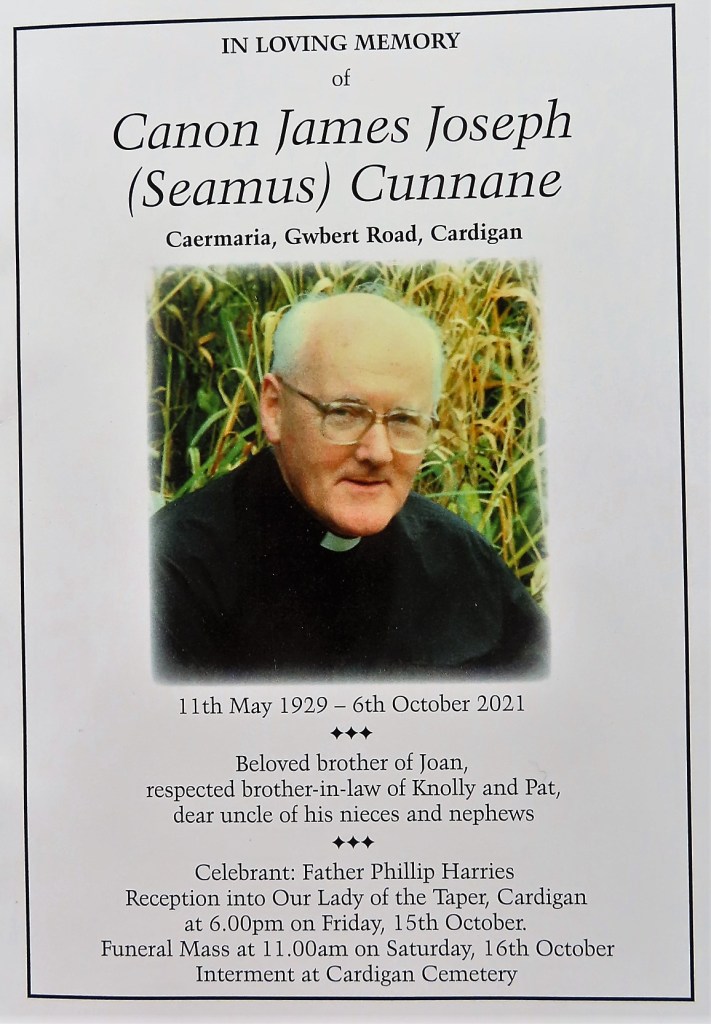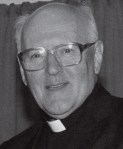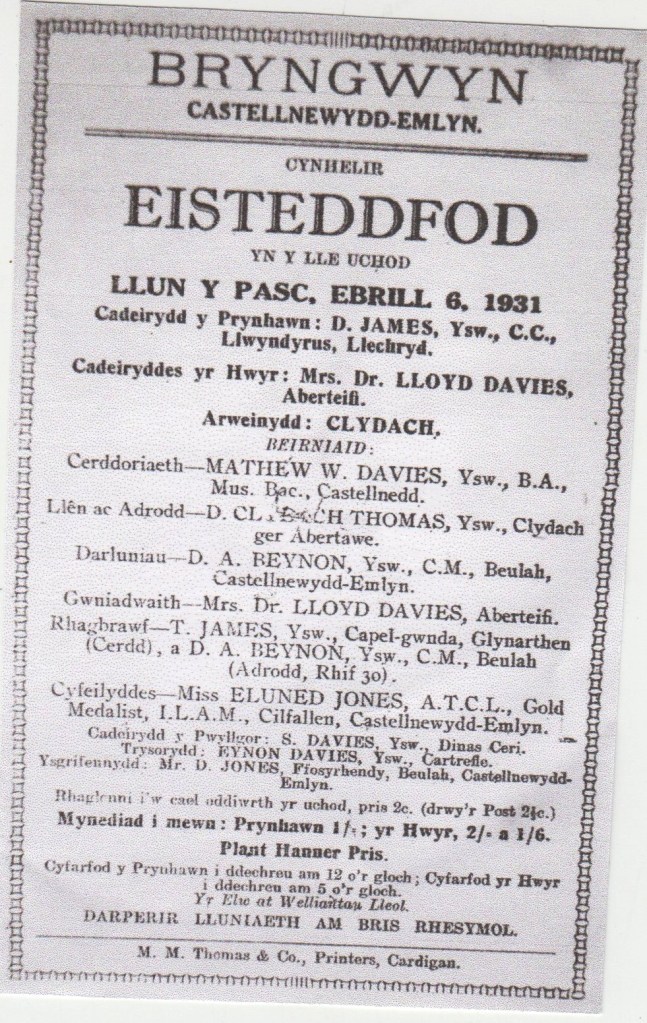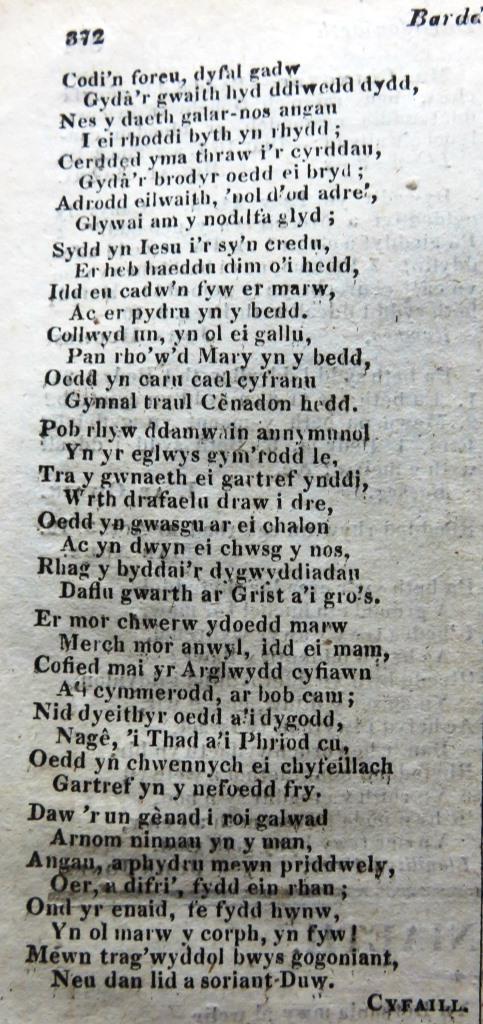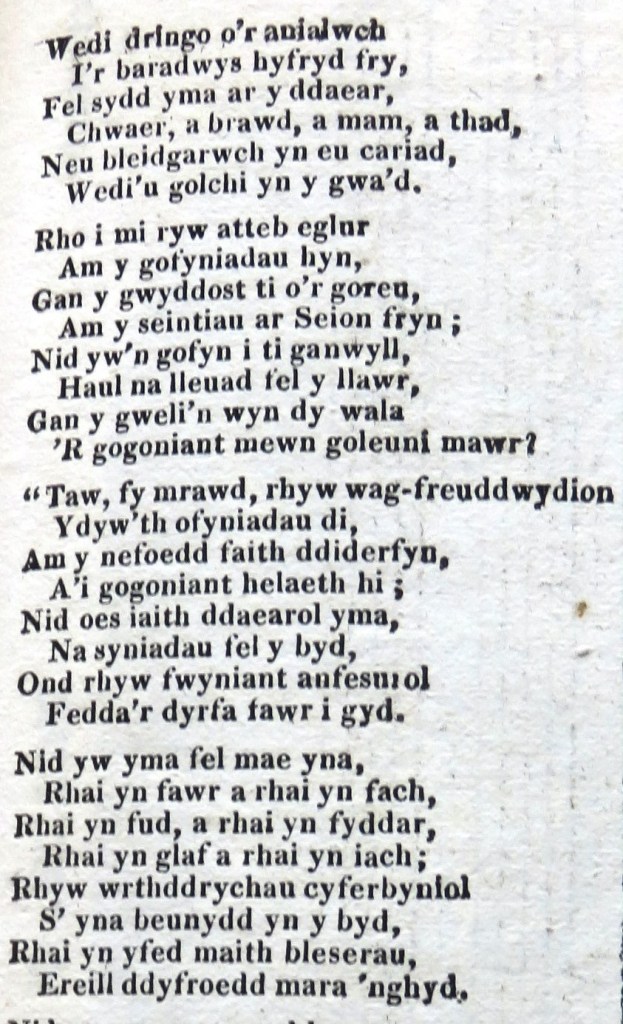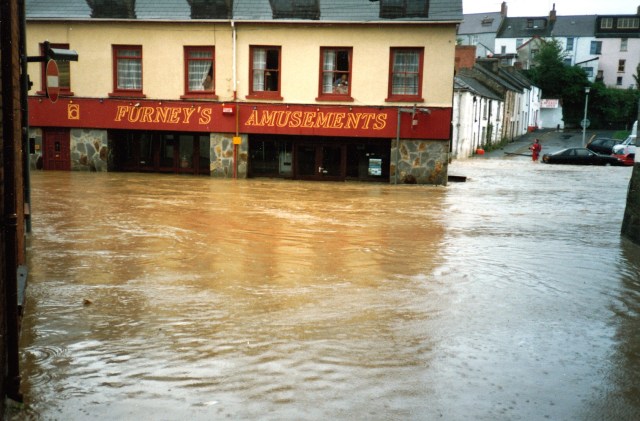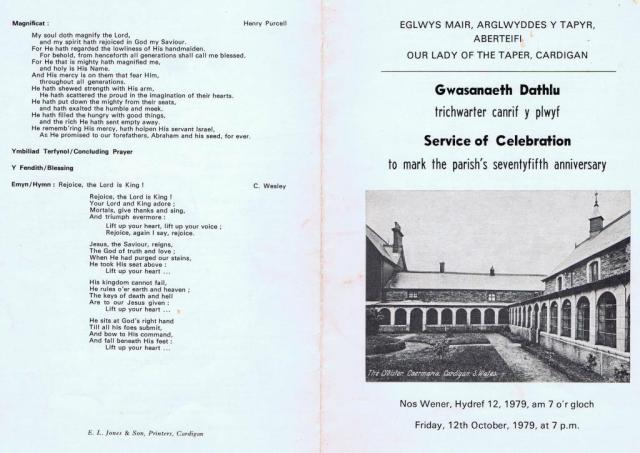Category: Religion
Cardigan People 54: Seamus Cunnane (1929-2021)
Father Seamus Cunnane served as Cardigan’s Roman Catholic parish priest for 37 years from 1962 until 1999. His contribution to all aspects of life in Cardigan over the decades was considerable. The present Catholic church and its hall were built in the early 1970s and Fr Cunnane was closely involved in much of the fundraising for the project. His lifelong dedication to the Catholic Church will, no doubt, be discussed elsewhere.
As a keen local historian, Fr Cunnane extensively researched the history of Cardigan and its castle and it is worth focusing on his pioneering role in revealing Cardigan’s medieval past. His knowledge of Latin and his fluency in Welsh allowed him to research original sources. This was crucial to him. Never rely on secondary sources! Once he discovered the facts it was important that the truth was clearly articulated. He never minced his words.
As far back as 1992 he wrote: “For over 10 years I have taught local history and I do not want my work undone by inaccurate captions and descriptions that will doubtless be copied by schoolchildren and others.”
He had a dim view of Emily Pritchard’s, Cardigan Priory in the Olden Days, 1904.
“This was taken apart in 1905 when a reviewer commented: ‘The opening words of the first chapter are at once an indication of the author’s unfitness for her task.’
The trouble is that reviews disappear while the book remains and continues to mislead.”
He wrote a number of groundbreaking articles on medieval Cardigan including:
‘Ceredigion and the Old Faith’, Ceredigion, vol 12, 2, 1994, 3-34
‘The Topography of Mediaeval Cardigan’ in Carmarthenshire and Beyond: Studies in History and Archaeology in memory of Terry James, ed. Heather James and Patricia Moore, 2009, 204-23
He was also the author of:
Our Lady of Cardigan: a history and memoir, E. L. Jones, 2006, 56pp.
He enjoyed writing and arguing his case in the Tivy-side over the years, often disagreeing with published accounts of Cardigan history regardless of whether they were written by lay or academic historians.
The following is a list of some his letters and articles with comments:
‘The Four Gates’
The story behind Cardigan’s Teifi Gate; Wolf Gate; Bartholomew Gate and New Gate
31 Dec 1982
‘Llywelyn ein llyw olaf’
Llywelyn’s contact with Cardigan
December 1982
‘Pride of the Town’
It was time to make the Castle the pride of the town.
29 July 1983
- ‘It is likely that … (Gilbert de Clare) founded the Benedictine priory and St Mary’s Church…’ He certainly didn’t.
- ‘In 1165 the Welsh under Rhys ap Gruffudd expelled the English monks from their priory…’ No evidence (apart from Emily Pritchard’s book).
- ‘burgage figure of 172 in 1308’. The figure of 172 is suspect.
- ‘Here also (near College Row) was the North Gate … standing in 1843.’
A misunderstanding of W. E. James’s Guide Book (1899) where he is referring to the turnpike gate at the top of Pendre. - Town walls: ‘At the corner of College Row and Queen’s Tce the wall turned south along the Mwldan’. Not quite.
- On St Mary’s St he is absolutely wrong.
- On Chancery Lane he is even more grievously in error.
A review of The Towns of Medieval Wales, Ian Soulsby, 1983:
After some introductory words of praise he states that in relation to the part on Cardigan, “the book contains serious errors because [the author] relies on articles and books, some of which are wrong, instead of going to the primary sources. Twice he misunderstands the sources he uses and thus invents new errors.”
His conclusion: “in a future edition rewrite the Cardigan section.”
29 July 1983
‘Throwing new light on the history of Cardigan.’
In answer to the Revd D J Roberts’ queries in his weekly articles in the Tivy-side concerning the town’s history, he explains the origins of Mwldan, Pendre, Bartholomew Gate and Wolf Gate.
15 February 1985
‘Henry Tudor’s march through Cardigan 500 years ago’
A detailed description of life in Cardigan on Henry Tudor’s visit.
9 August 1985
‘In defence of Welsh history’
He writes: “Today you published an article on the medieval history of Cardigan and its castle called ‘The lock and stay of all Wales’ on a page carrying the rather incrongruous title ‘News Extra’. Much of it was indeed news to me, but only in the sense that it is demonstrably untrue.”
He restricts his comments to twelve headings and ends: “It is time to show respect for fact, and it is a pity that the Tivy-side showed such little regard for it…”
1 June 1990
‘The Mystery of Dydd Iau Mawr (Great Thursday) celebration at Aber-porth.’
The Thursday before 15th August – a Catholic celebration of Gŵyl Fair Gyntaf
9 August 1991
‘Statue not an idol and not adored’
Fr Cunnane disagreed with a caption written in the Time Tunnel exhibition where reference was made to ‘the existence of the idol: The Lady of the Taper’. His comment: “That is an untruth. The statue was not an idol and was not adored.”
4 September 1992
‘The day they hanged the vicar’
An account of the trial of Sir Hugh David Coch, vicar of Llanarth, and his subsequent fate in being hung, drawn and quartered on Banc y Warren in 1592.
28 May 1993
‘Cardigan development plan good news but…’
He writes: “We do not want hamfisted ‘development’ that ruins our heritage”
(and goes on to explain the origin of the name Chancery Lane or Suitor’s Lane)
21 July 1994
‘Monks arrived via Cardi Bach’
He corrects a few inaccuracies in a recent television programme concerning the Benedictine monks at Noyaddwilym and writes:
“Many locals did not like them, including the Tivy-side editor and several correspondents, but we must not tar everyone with the same brush.”
5 July 1996
‘Don’t dump part of our town’s history’
He writes: “Ceredigion wants to dump responsibility for a road named Bingham Lane. But there is no such place. Its name is Feidrfair … [and it is part] of the great medieval pilgrim route from Bardsey Island to St David’s.
Ceredigion [County Council] should publicise and enhance it. Instead it is ducking responsibility and some of us think this is shameful.”
27 November 2012
A few years back I attended a lecture by Prof Ralph Griffiths at the Catholic Hall under the auspices of Ceredigion History Society. His account of Medieval Cardigan in the broader regional context was enlightening but in the post lecture questions it was clear who knew most about Cardigan. On the way out someone turned to me and said “I don’t think they chose the right person to give that talk today.”
But he was not in any way stuck in the Middle Ages. Recent research into the swinging sixties in Cardigan revealed that he was proud to shake the hand of Screaming Lord Sutch during his infamous visit to the town to perform at the Black Lion in April 1964.
The complete story of early Cardigan remains to be told, but Fr Cunnane has set a firm foundation for future historians.
RIP Seamus Cunnane.
TRIBUTES
Boring sermon? Where’s the saw!
Cardigan People 47: Helen Samee
On 4 December 1823 John Lloyd, the curate of St Mary’s Church baptised Helen, the child of Ramo and Helen Samee.

Does the name ring a bell? Ramo Samee (1791-1850), her father was a famous Indian juggler and magician.
He and his wife came over to Europe around 1810, and he made a tour of the United States in 1819. He was quite a showman:

Samee performed a trick he called “stringing beads with the mouth”, in which he “swallowed” a handful of beads and a piece of string, then pulled the beads out of his mouth, one by one, tied to the string. Samee was also a sword-swallower (swallowing 2 foot long swords!) and a fire-eater. In his fire act, he would light a piece of rope, place it on a plate, and proceed to “eat” it as a meal. He called it his “light dinner”.
William Hazlitt’s essay The Indian Jugglers (Table Talk, 1828) provides an interesting account although Ramo is not named.
In July 1823 he performed in Swansea as this advert in The Cambrian shows:
He died in 1850, so poor that his wife had to advertise for financial help to bury him.
The big question, of course, is what was his connection with Cardigan? Did he live here or was the family just passing through?
In the 1881 Census return for London (West Hackney) Helen (or Ellen by then) Samee’s birthplace is given as Cardigan, and the records of St Mary’s Church show that she was baptised here.

She and her mother are described as Needlewomen but life was hard and they both spent periods in the Workhouse during the second half of the nineteenth century (discharged on 26 Apr 1850 and again on 2 June 1882). Ellen Samee died in 1884.
If the Tivy-side had been published in 1823 I wonder what their headline would have been:
Daughter of famous Indian juggler baptised at St Mary’s, perhaps. Perhaps not.
Cardigan People 46: Derek Greenslade Childs
from William St. to Llandaf Cathedral;
from a baker’s son to Archbishop of Wales
Derek Greenslade Childs (14 January 1918 – 18 March 1987)
According to ‘Wikipedia’ Childs grew up in Laugharne. No mention is made of his birthplace.
He has not reached the Dictionary of Welsh Biography yet.
But Derek Greensalde Childs was baptised on 10 March 1918 at St Mary’s Church, Cardigan by B. J. Jones, the curate. His parents were Alfred John and Florence Theodosa. The address given was 17 William St., Cardigan
Alfred came originally from Laugharne, and Florence (Jones) lived in 17 William St. They were married on 17 March 1916 at St Mary’s Church. Presumably Alfred came to live in Cardigan at that time. His occupation is given as baker.
Derek was educated at Whitland Grammar School, before reading history at University College, Cardiff. He studied theology at Salisbury Theological College, before being ordained in 1942.
Derrick Greenslade Childs was the Anglican Bishop of Monmouth (1970-86) and Archbishop of Wales (1983-86).
He died as a result of a motor accident in 1987.
Living authority: Essays in memory of Archbishop Derrick Childs was published in 1990.
1931: 90 years ago
Cardigan People 38: Margaret Nicholas (1750–10.10.1829)
Cardigan People 37: Mary Owen (1769–13.9.1829)
Cardigan People 36: Mary Davies (d. 29.7.1829)
Cardigan People 35: S. Williams (1777–17.1.1832)
S. Williams, merchant who died in 1832, a few years before the first Census in 1841. A prominent Baptist in the town. No indication where he was buried.
Cardigan People 33: Mary Phillips (1770–1830)
Greal y Bedyddwyr, 1830
Cardigan People 31: Revd John Herring (1789–1832)

Revd John Herring was the minister of Bethania Chapel from 1811 until 1832. He died after an illness that lasted some months. He left a wife and 7 small children. What else do we know about him?
The piece in the Dictionary of Welsh Biography can be read here:
https://biography.wales/article/s-HERR-JOH-1789
Well there is a story that one fine summer’s day in July while he was on one of his preaching tours in north Wales, he met the famous Revd Christmas Evans who took one look at him and said “What a strange thing to see a herring on top of a mountain”. Quick as a flash Herring replied “ Surely not more than to see Christmas in the middle of summer?” Touche as they say.
In another version the two were on top of the Frenni Fawr. By 1909 the story had changed a bit:
Christmas Evans and John Herring meet. When Mr Herring saw his friend, he shouted ‘Strange, strange, to come across Christmas in the middle of summer.’ ‘Yes, it is’, replied Mr Evans, ‘but stranger still to meet a live herring on top of a mountain.’
His unusual surname was an opportunity for many a story: Once, down in Llanboidy, he was preaching so eloquently that Mr. Powell, Maes-gwyn, a prominent local man asked ‘Who is that? ‘Herring, Cardigan’ was the reply from someone sitting nearby. ‘No, not a herring, he said but a Salmon.
But there is more to the Revd John Herring than an unusual surname.
In 1836, four years after his death D. Roberts, Llandiloes, published a booklet entitled: Derwen Wylofain.

The short biography included reveals a little of his background:
John was born to Thomas and Sarah Herring, Llanyspyddyd, Breconshire in 1789. His father died when John was 4 or 5 years old. His mother remarried and the family moved to the iron works at Ebbw Vale. John was employed at the local blacksmith.
His humorous character was revealed early on. ‘How many sects are there?’ he asked his employer one morning.
‘I think there are five of any use, and those five are in our house. My stepfather is Indepenent, my mother a Methodist, I will go to the Quakers and I’ll make my cat a Wesleyan and the little dog a Baptist’. Indeed he took his dog with him one Sunday morning to see a baptism in the Sirhowy river by Tredegar deciding to throw the dog in the river when the Revd Edward Davies was preaching. But it was not to be. Listening to the sermon he became a believer and it was he who was baptised and not the dog. He became a member of the Baptist Church at Tredegar in 1804. [Siloh says Revd. B. James (Edwards, Bethania, p. 30)]
The rest, as they say, is history…
He began preaching when he was 16 years old. Under the influence of the Revd John Hier, Basaleg, he was accepted as a student in the Colege at Bristol when he was 20/21 years old. He had had enough after a year. ‘What is the use of Hic, Haec, Hoc, to save souls’
On a preaching tour he was invited to Bethanis and accepted a calling in 1811. He remained there until his death in 1832.
- He was an exceptional preacher.
“he was one of the funniest and most popular preachers of his day”
“he was possessed of a prolific understanding, a multitude of words, a natural and effective eloquence, a tenacious memory, proper gestures, a melodious voice
But he wasn’t a perfect man ‘despite his excellent qualities he was not without his weaknesses’ (these are not listed).
- He was an excellent organiser. He drew up a list of rules and regulations on to how to organize a Church in a pamphlet entitled: ‘‘Penderfyniadau i’w gosod mewn gweithrediad yn Eglwys y Bedyddwyr yn Methania, Aberteifi, a fabwysiadwyd mewn Cyfarfod a gynhaliwyd Tachwedd 18fed, 1829,’ [Decisions to be undertaken at Bethania Baptist Church, Cardigan, and adopted in a Meeting held on 18th November, 1829’]. He elaborated on many issues: Covetousness–its harm; Generosity–its appeal; Ministers–their maintenance; The Poor–how they should be considered; Discipline–its rule; the neglect of assembling.
- He was a litterateur: He edited the Greal y Bedyddwyr for a year, and then for a further two years with J. M. Thomas.
He died at Llwynpiod, Cardigan on 2 April 1832, after an illness that had lasted some months. He was buried at Cilfowyr.
He married twice. First to Elizabeth, the daughter of the Revd Griffith Davies, minister of Rehoboth. She died in 1823 leaving three daughters: Mary, Elizabeth and Anne. His second wife was another Elizabeth (Lewis, Crugmor.) They had four children from this marriage.
His second wife died a fortnight after John leaving seven orphans – among them:
Ann, 12 year old (blind and of unsound mind); Dinah, 8 year old (later married James Morse, Trehowell); James, 7 year old. He is listed in 1901 as a retired mariner and living in Northgate Tce. He had married the daughter of the Revd. T. J. Morris and was a member of Capel Mair. He died in 1907; Sarah, 4 year old; Eleanor 2 yea rold. She is listed in 1851 as a housekeeper in Quay St; in 1861 as a housemaid in St Mary St (to Thomas Morgan, solicitor). She was a member at Bethania and died in 1898.
A number of prominent people from the chapel and surrounding district established a fund to help the children.
David Mathias, Cardigan
Timothy Thomas, the elder
William Richard, Penyparc
Daniel Davies (Independent minister), Cardigan
John Morgan, Blaenffos
Daniel Davies, Swansea
Awdl Bryddest Farwnadol i’r diweddar Barch. John Herring, Aberteifi: An elegy to the late Revd John Herring, Cardigan by Asaph Glyn Ebbwy (Thomas Williams, Tredegar). Please see the Welsh version for the 30 verse elegy!
Cardigan People 24: Owen Roberts, Feidrfair, sailor, cook (1848–1904/05)
A note in Bethania Chapel Minutes first brought Owen Roberts to my attention. Under a list of deaths for 1905 is the following:
Owen Roberts, Feidrfair. Hwyliodd o China i Vladivostock Hydref 1904. Ni chlywyd dim oddi wrthynt drachefn yn yr SS Claverdale.
[He sailed from China to Vladivostock in October 1904. Nothing more was heard of them in the SS Claverdale]
A bit of Googling revealed a few interesting items.
Under the heading ‘Fate of the Claverdale’ the Evening Express published the following account on 31 January 1905:
A boat belonging to the overdue British steamer Claverdale has been picked up and taken to Fukuyajna. None of the crew was on board. The Claverdale left Barry on September 1 for Manila, with a cargo of between 5,000 and 6,000 tons of coal on Russian account. On October 29 she was reported at Sabang, and on November 23 left Hong Kong for Vladivostok. Nothing has been heard of her since, and it is presumed that in running the blockade she kept in too close to the land and struck a sunken rock. Captain Thomas, the master of the Claverdale, is a native of Cardigan, and is well known in Cardiff shipping circles.
The Claverdale was the pioneer ship of the Claverdale Steamship Company (Limited), owned by Messrs. E. Haslehust and Co., who claimed that this is the first vessel they had lost. She was built in 1899 by Messrs. Graig, Taylor, and Co., of Stockton-on-Tees, is 330 feet long, with a 45 feet beam, and a draught of 18 feet, while her engines registered a nominal horse-power of 278.
[Correction gratefully received from Mr Reg Nash: “the Claverdale Steamship company, owned by E. Haslehust (not Hazelhurst) and Co., had two ships called the Claverdale. The one you mention was sold in 1903 and replaced by a second, built by J. Priestman & Co. of Sunderland. This new Claverdale was launched on May 31 1904. She was 345 feet long and 48.8 feet in beam, with a draught of 20.9 feet; her nominal horsepower was 357 (National Archives BT 110/116/30). I have a copy of the blueprint plans, courtesy of the National Maritime Museum. It was her maiden voyage that ended so tragically.]
By 09 September 1905 the Cardiff Times reported that a Vladivostok telegram dated August 31st stated that a steamer stranded north of Olga was reported to be the missing British s.s. Claverdale, bound from Cardiff to Vladivostok via Hong Kong.
But further inquiries found that the rumour was not true and the reporter on the Cardiff Times was not happy:
This is the second time that such a report has been cabled home from Vladivostok respecting the same ship, and it is unfortunate that the authorities do not make an effort to secure the name of the stranded vessel before telegraphing to England.
The mystery of the missing ship seemed to have been solved by November 1905, according to a report in the County Echo, quoting the Daily Chronicle:
Dispatches received in London reveal for the first time the identity of the wreck which has frequently been sighted to the south of Vladivostok, near the mouth of the Tandse River. The vessel turns out to be the British steamer Claverdale, which left a Chinese port last November with a full cargo of coal for the Russian cruisers at Vladivostok, and which has not since been heard of. As the result of a visit paid to the stranded steamer, it has been ascertained that the vessel has been pillaged by the natives in the neighbourhood, and every article of value taken away. The inhabitants residing in the vicinity, who were interrogated, declared that the crew of the Claverdale’ were removed shortly after the wreck by two boats presumed to be Japanese.
But the missing crew remained missing : Neither owners nor relatives, however, have heard from any of the men. By November 1905 the headline in the Weekly Mail suggested that worse was to come.
WRECK OF THE CLAVERDALE: SUPPOSED MURDER OF MEMBERS OF THE CREW.
The crew who are supposed to have been killed on the Manchuria coast, where the ship was wrecked, included:
H. H. Thomas, Cardigan, commander;
D. Llewellyn, St. Dogmaels, mate
James Reed, Swansea, second mate
D. Jones, Cardiff, carpenter
J. S Campbell, Sunderland, steward
Owen Roberts, Cardigan, cook
Watkin Evans, second steward
John Waddle, boatswain
A. Tripolis, A.B. seaman
R. Thomas, Liverpool, A.B. seaman
G. Marromatic, A.B. seaman
Frederick Cooper, Sunderland, chief engineer
Frederick Walker, second engineer
James Beadle, Sunderland, third engineer
Cornelius Gray, Sunderland, fourth engineer
Carl Lundin (of Sweden), donkeyman
Richard McGuire, Bootle, fireman
B. Mynes, Brumiskin, fireman
W. Flagg, fireman
Gus Langer, fireman
R. J. Jones, fireman
S. Ostovski, fireman
W. Howrie, apprentice
G. B. McLaren, apprentice
Reginald Turner, North-street, Lewes, apprentice
G. A. Saunders, Kingston-road, Portsmouth, apprentice
In addition to these, two other hands, names and nationalities unknown, were taken on to Hong Kong. These were possibly Chinese.
[Additional information from Mr Reg Nash: Of the 27 to 30 men on board (sources differ) when she was lost four were from Cardigan:
Captain Thomas, aged 52, of Priory Street, Cardigan. He had previously lived at Ovingham House, Llangoedmore. (His widow, Laura née Morris, was the long-time headmistress of Llangoedmore School; her obituary is on page 1 of the Cardigan and Tivyside Observer dated 23/10/1925).
D. Llewellyn, the mate, aged 47, was born in St. Dogmaels, which is also given as his address (no further details).
Owen Roberts, the cook, aged 56, was born in Holyhead, and his address is given as 26 Mary’s Crescent, Cardigan.
David Jones, the carpenter, aged 43, was also born in Cardigan, but his address is given as 172 Corporation Road, Cardiff.]
It was claimed that the ship had been boarded by Manchurian pirates and the crew thrown overboard.
In March 1906 the Cardiff Times reported on the proceedings of the Probate Court where the captain named as Edward Evan Thomas, Llangoedmore was presumed dead:
The vessel was found 450 miles north of Vladivostok ashore in the Gull of Tartary deserted, with her decks dismantled. In February, 1905, a boat belonging to the ship was found, and in May the ship was posted at Lloyd’s as a total loss. Eventually the vessel was discovered a total wreck, and only about 300 or 400 tons of cargo remained. The master and crew had disappeared. Captain Thomas left about £1,400. His Lordship granted leave to presume the death of Mr Thomas accordingly.
[Further details from Mr Reg Nash: When the Claverdale reached Hong Kong it was revealed that she would be going on to Vladivostok, which was being blockaded by the Japanese during the Russo-Japanese War. Several ships had already fallen victim to the blockade. Consequently the crew, who had been hitherto unaware that they would be sailing through a war-zone, were given the option to leave the ship. Seven men did so including David Jones, the second mate, aged 29, born in Cardigan, address 1 Greenfield Row, Cardigan; there is a brief interview with him on page 2 of the Cardiff Evening Express dated 12/1/1905. As to the fate of the Claverdale I have little to add. It seems pretty certain that to avoid the Japanese blockade she took the much longer route to the east of Japan and was thus having to negotiate the la Perouse strait and approach Vladivostok from the north. Possibly her rudder was put out of action in the hostile winter environment, as happened to at least one other vessel at this time. The precise location of the wreck is also a mystery. Contemporary reports, including one from the Salvage Association, say that she was found at the mouth of the Taudse (or Tandse?) River, north of Ternei Bay, but I have been unable to discover a river of that name.]
After all this we’re none the wiser, I’m afraid, as to what actually happened but suffice to say these brave local sailors probably came to a watery end: H. H. Thomas, Cardigan, D. Llewellyn, St. Dogmaels, and Owen Roberts, Cardigan, the cook from Feidrfair.
If a photograph exists of any of these gentlemen I would be pleased to add a copy here.
Cardigan People 22: Goronwy Moelwyn-Hughes MP (1897–1955)

Goronwy Moelwyn-Hughes was born in Priory St* on 6 October 1897 the eldest son of the Revd J. G. Moelwyn-Hughes (1866–1944) who was the minister at Tabernacle Chapel. He attended the local schools before heading for UCW Aberystwyth. During WW1 he served with the West Yorkshire regiment, was wounded , transferred to the Royal Flying Corps and served as a pilot (1917–19). He then returned to Aberystwyth, graduated as BA, entered Downing College, Cambridge where he obtained first-class honours in the law tripos. He was called to the bar in 1922. He fought two unsuccessful general elections for the Liberals in the Rhondda in Nov 1934 and Cardiganshire in 1935. He was the elected unopposed at a by-election in Carmarthen in March 1941, a seat he held until 1945. He was then returned as Labour MP for North Islington in 1950 but retired due to ill health in 1951.
He was appointed as a commissioner for inquiry on to the Burnden Park, Bolton football disaster in 1946, when 33 spectators were crushed by the pressure of numbers. He recommended that football grounds be made subject to safety licensing.
*[Llwyn Onn according to the Oxford Dictionary of National Biography, but according to 1901 Census Finch’s Sq. The family were living at Glasynys, Priory St. in 1911 (census)]
He frequently returned to Cardigan to visit his parents. Here is an interesting (silent) film he made of his visit in 1933.
https://player.bfi.org.uk/free/film/watch-haf-1933-cardigan-1936-online
27 December (1898) Burial of 19 year old son of Revd. T. J. Morris, Capel Mair
- 27 1898 (Tues.) Burial of John James Morris, 19 years old, son of Revd T. J. Morris, Capel Mair.
- 27 1888 (Thurs.) Burial of David P. Walters, The Strand, 52, mariner
25 December (1176, 1888, 1889, 2103) Merry Christmas to all who were born within the sound of the bells of St Mary’s
-
25 December (Wed.) 1176 The first Eisteddfod
And then the Lord Rhys held a special feast at Cardigan, and he set two kinds of contests: one between the bards and the poets, and another between the harpists and the crowders and the pipers and various classes of string-music. And he set two chairs for the visitors in the contests. And those he enriched with great gifts. And then a young man from his own court won the victory for string-music. And the men of Gwynedd won the victory for poetry. And all the other minstrels received from the Lord Rhys as much as they asked, so that no one was refused. And that feast was proclaimed a year before it was held throughout Wales and England and Scotland and Ireland and many other lands.
1176 Brut y Tywysogyon
- 25 (Tues.) 1888
CAPEL MAIR
A very successful concert was given in Capel Mair, in this town, on Christmas night, under the presidency of the Rev. W. Jones (Mayor). The building was well-filled, and excellent order was maintained throughout by the conductor, the Rev. T. J. Morris, which was certainly not the least pleasing feature of the gathering. The programme was contributed to by a number of local amateurs, assisted by Eos Myrnach, and a male party from Llanfyrnach, and it will not be considered invidious to say that it was in a great measure owing to their valuable assistance that the concert was one of the best that has been given in the town for some time.
Eos Myrnach possesses a capital voice, and sang several high-class songs with excellent taste and feeling. His rendering of “Alone on the raft” was particularly deserving of mention.
The Llanfyrnach male party, too, proved a great acquisition, and gave evidence of close and careful training, and their rendering of the choruses allotted to them was admirable. “Comrades Song of Hope,” and “Martyrs of the Arena” — the latter including a splendidly rendered quartet- fairly delighted the audience, and were deservedly encored. Mr. Davies led the Llanfyrnach party in the first chorus, and Eos Myrnach afterwards.
Among the locals, the Capel Mair party, led by Mr. Reynolds; Mr. W. Thomas and party, Mr. D. Charles and friends, and Mr. D. Davies and friends, were deserving of commendation, as were also Misses Lowther and Letitia Evans, and Mrs. Jones, and Messrs. W. Thomas, D. Thomas (Tyrhos), and T. Lewis. Miss Daniel and Miss Edith Daniel accompanied with much taste throughout the evening.
The following is the programme:
- Pianoforte duet, The Little Sailor, Misses Daniel and Lowther;
- glee, Croeso’r Boreu, Capel Mair Party;
- solo, Gitana, Miss Lowther;
- glee, “Beautiful Rain,” (encored and repeated) Mr. W. Thomas and party;
- solo, “Llwybr yr Wyddfa,” (encored and sang Bwthyn bach melyn fy Nhad”)
- Eos Myrnach quartet, “Geiriau Mam,”
- Mr. D. Charles and friends solo,
- Mr. D. Davies solo, Baban diwrnod oed,” (encored)
- Mr. D. Thomas, Tyrhos .Song, Darby and Joan,”
- Miss Letitia Evans chorus, “Comrades Song of Hope,” (encored)
- Llanfyrnach Party solo, Jerusalem,”
- Mr. T. Lewis; duet, “As it fell upon a day,”
- Misses Lowther and Evans. Part 2-Glee, Yr Haf,”
- Capel Mair Party duet, O Gartref yr Eryr,” (encored and sang a duet from Blodwen “)
- Eos Myrnach and Mrs Jones solo, Hen Ffon fy Nain,” (encored)
- Mr. D. Thomas, Tyrhos; solo, Alone on the Raft,” (encored)
- Eos Myrnach; chorus, “Y Gof,”
- Llanfyrnach Party; solo, Pleser-fad Niagara,”
- Mr. W. Thomas;
- trio, Tri Chymro,” (encored)
- Mr. D. Davies and friends; chorus, “The Martyrs of the Arena,” (encored)
- Llafyrnach Party
- finale, Hen Wlad fy Nhadau,” air by Eos Myrnach and chorus by the audience.
Votes of thanks to the Chairman and those who took part concluded the proceedings (probably early Boxing Day!)
- 25 (Wed.) 1889
BETHANIA CONCERT
A grand evening concert was given in Bethania Chapel on Christmas night, and there was a crowded audience. A letter was read from Mr. Morgan-Richardson, Noyadd-Wilym, who had been announced to preside, regretting his inability to attend, and inclosing £2 towards the funds. In the absence of the chairman, Mr. W. Lewis, Brecon Old Bank, was unanimously voted to the chair. The Rev. T. J. Morris acted as conductor.
The following was the programme :
- Pianoforte solo, Miss Gwynne, R.A.M. solo, “Baner ein Gwlad,”Gwyn Alaw” (encored, and responded with “My Pretty Jane”);
- solo, “Remember me,” Miss S. A. Esau;
- solo, Death of Nelson,” Mr. Wm. Thomas (encored, and responded with a Welsh song);
- solo, The Blind Girl to her harp,” Miss S. A. Jenkins (encored, and responded with “Trip, Trip”);
- solo, “I had a dream,” Mrs. S. A. Owen;
- solo, The White Squall,” Mr. W. Jones
- solo, “O dywed im’, awel y Nefoedd,” Llinos Gwent;
- solo competition, “Mair Magdalen,” ten competed, three singing on the stage, the best being Miss Lizzie Jenkins, Greenfield-square
- duet, Martial Spirit,” Gwyn Alaw and Mr. William Thomas;
- juvenile choir competition, Y Galwadau,” three choirs, namely, Bethania (led by Mr. William Jenkins), Tabernacle (led by Mr. John James), and Mount Zion (led by Mr. D. Ivor Evans), and the prize was divided between Bethania and Mount Zion
- choirs quartet, Mount Zion Party duet, “Howel, Howet, Llinos Gwent and Gwyn Alaw (encored, and repeated);
- solo, Pleserfad Niagara,” Mr. William Thomas;
- solo, Good Shepherd,” Gwyn Alaw
- solo competition, Y Morwr Lion,” five entries, prize awarded to Mr. William Jones
- choral competition, Cwynfan Prydain,” two choirs competed, namely, Tabernacle (led by Mr. E. Ceredig Evans), and Bethania (led by Mr. William Jenkins), and the prize was awarded to Bethania Choir
- song, Aunty,” Llinos Gwent (encored, and responded with The Donkey Cart”)
- finale, Hen Wlad fy Nhadau.”
It is but fair to say that the singing of Miss S. A. Jenkins (Llinos Gwent) was much admired she possesses a beautiful soprano voice of great power and compass, and should have a great future if she becomes a professional singer. Votes of thanks to the Chairman, Mr. Morgan-Richardson, the Conductor, Miss Gwynne (the accompanyist), and the singers, concluded the proceedings.
- 25 1888 (Tues.)
THE WORKHOUSE.
On Christmas Day the inmates of the Workhouse were, as usual, through the generosity of Mr. Brigstoike, the much respected chairman of the Board of Guardians, treated to a splendid dinner, composed of roast beef, plum pudding, and beer, with two ounces of tobacco to those who smoked, and oranges to those who did not, and to the women and children.
Mr. Thomas Llewelyn and Mr. Lewis Davies superintended the distribution. A hearty vote of thanks to Mr. and Mrs. Brigstocke for their kindness, to Messrs. Llewelyn and Davies for superintending, and to the master and matron for the great trouble they had taken in preparing the good things, were unanimously passed.
Dinner being over, Mr. John James, St. Dogmells, and his choir, attended, and several pieces were sung, to the great delight of the inmates.
- 25 1909 Bethania
- 25 (Wed.) 2013 Tonight it’s Downton Abbey v. Mrs Brown’s Boys Christmas Special (Progress or what?)
MERRY CHRISTMAS TO ALL WHO HAVE READ THESE SNIPPETS OVER THE YEAR.
Next year – more meat on these bones!
17 December (1869) For sale: Cardigan Commons
- 17 1908 (Thurs.) Burial of Reverend T. J. Morris, North Gate Terrace.
- 17 1904 (Sat.) Burial of Ernest Smith Allen, photographer, 35 years old
- 17 1869 (Fri.) A Public meeting decided to sell 60 acres of Cardigan Commons to reduce the Council’s £7, 500 debt. The chairman was Dr John Thomas, the mayor.
13 December (1908) Death of Revd T. J. Morris, Capel Mair
12 December (1986) Floods in the Mwldan again!
4 December (1900) Burial of a former vicar
- 4 1900 (Tues.) Burial of William Cynog Davies, Vicarage, 67 year old former vicar of St Mary’s Church.
2 December (1887) First Salvation Army funeral at the cemetery
- 2 1936 (Wed.) Grand Celebrity Concert at the Pav: Cardigan County School Choir. Conductor: Leslie W. Evans; Bass-Baritone: Idris Daniels; Tenor: Haydn Adams; Soprano: Jennie Evans-Jones; Contralto: Mattie Davies; with Dan Matthews, Pontardulais.
- 2 1887 (Fri.) First Salvation Army funeral: Thomas Davies, Mwldan.
26 November (1950) Last sermon of Revd. E. Lee Hamer at St Mary’s Church
21 November (1896) School closed for a week due to mumps
- 21 1955 (Mon.) Second day of the 3rd Jubilee Meetings at Capel Mair
- 21 1896 (Sat.) National School closed for a week due to mumps
6 November (1968) 1st sod cut at site of new Catholic Church (1912) Pav opened
6 1968 (Wed.) 1st sod cut at site of new Catholic Church. Contract of £49, 700
PRIESTS:
- Joseph Higgins 1930-32
- John Tole 1932
- Wilfred Brodie 1932-3
- Basil Rowlands 1933-36
- Thomas Williams 1936
- Joseph Wedlake 1937-9
- Thomas Canning 1940
- James McAniff 1941
- B. O’Connell 1942-5
- Phillip Dwyer 1946-7
- William Andrews 1947
- Albin Kaltenbach 1947-51
- George A. Anwyll 1951-9
- Raymond Joyce (curate) 1951-9
- John McHugh 1950-61??
- Arthur Davies 1961
- Seamus Cunanne 1962-99
- Augustine Paikkatt 1999-2003
- Jason Jones 2003-
- Paul Joseph
- 6 1912 (Wed.) Pav (The Pavilion Cinema) opened at 7.30 by the Mayor Ivor Evans. In the interval Cardigan Male Voice Party (conductor H H Evans) sang ‘Martyrs of the Arena’. Admission 3d, 4d, and 6d. Children half-price. Sold to H D Claypole, Pembroke Dock in 1919 and he was responsible for forming the Cardigan Cinema Co. Ltd. First workers: Mechanic operator: Harold Squibbs; Hall and door keeper: Tom White Jones; Pay Box attendant: Fred Mulraine; Pianist: Morien Peregrine; Indoor attendants: John L Griffiths, W Johnson; engineer: Owen Williams
- 6 1908 (Fri.) Burial of John Conwyson Roberts, 20 Quay St., 67 years old
30 October (1993) Induction service of Revd G. Madoc-Jones
26 October (1880) Official opening of Hope Chapel
24 October (187) Revd W. Mydrim Jones began his ministry at the Tabernacl
- 24 1870 (Mon.) Revd W. Mydrim Jones began his ministry at the Tabernacl (until 1877). Trem ar ddwy ganrif o hanes y Tabernacl Aberteifi 1760–1960, C. Currie Hughes, page 19 – “Methwyd cael llun y Parch. Mydrim Jones”. – [Failed to get a photograph of Revd Mydrim Jones] – ditto.
17 October (1880) Ten baptised in the Teifi
- 17 1880 (Sun.) Ten persons were baptised in the river Teifi, at the Netpool, by the Rev. J. Williams, minister of Bethania Baptist Chapel, on Sunday afternoon last, in the presence of a large concourse of people. They were:
Griffith Griffith, son of Thomas Griffiths, grocer, Pendreuchaf; John Williams, son of William Williams, carpenter, Pendre isaf; David Jenkins, son of John Jenkins, waggoner, St. Mary’s St; James Thomas, sailor, Feidrfair; Anne Davies, daughter of Thomas Davies, a worker at Parcytrap; Anne Thomas, daughter to the wife of John Jenkins, stonemason, Pendre uchaf; Rachel Griffiths, daughter of John Griffiths, tinman, St Mary’s St; Frances Heyes, White Hart, St Mary’s St; Anne James, daughter of David James, Eben’s Lane and Margaret Jones, maidservant Mr Levi James, the ironmonger.
12 October (1979) Catholics celebrate 75 years
- 12 1979 (Fri.) Service of Celebration to mark parish’s 75th anniversary (Our Lady of the Taper) at 7.00
- 12 1914 (Mon.) Recruitment meeting held in the Pav. Speakers include Herbert M Vaughan MA, Llangoedmor, Vaughan Davies MP, Sir Edward Parry-Pryse Bart, Towyn Jones MP, and David Rhys.
11 October (1986) Induction of Revd Ifor ap Gwilym at Tabernacl
6 October (1897) A son for Moelwyn
- 6 1897 (Wed.) The wife of the Rev. J. G. Hughes (Moelwyn), Llwyn Onn, Priory-street, minister of Tabernacl, gave birth to a son.


